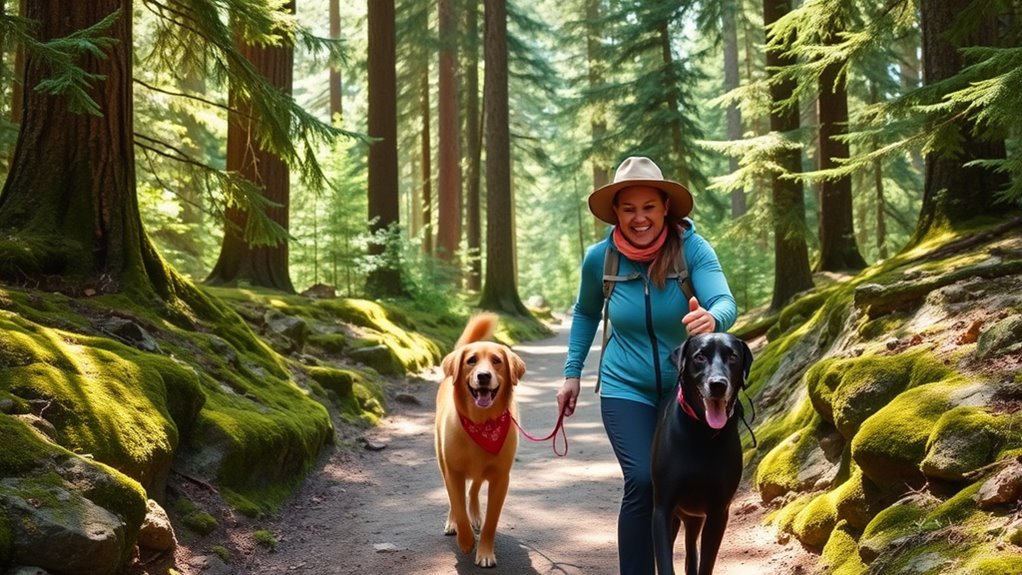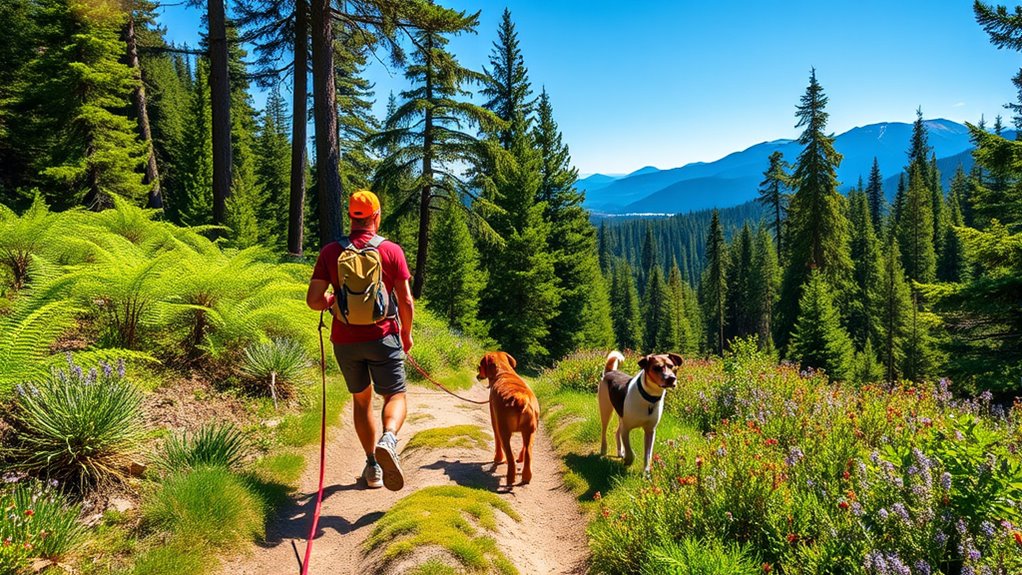When hiking with your dog, make certain they’re well-trained and stay under control by following leash laws and practicing trail etiquette, like cleaning up after them. Prepare in advance by confirming your dog is healthy, up-to-date on vaccines, and equipped with essentials like water and treats. Watch for signs of fatigue or overheating, and adapt your pace as needed. To learn more about making your outdoor adventure safe and enjoyable, keep exploring the best tips and strategies.
Key Takeaways
- Train your dog with commands like “come,” “sit,” and “stay” for reliable control on the trail.
- Follow leash laws and use secure, comfortable leashes to prevent your dog from chasing wildlife or running off.
- Prepare your dog with proper health checks, bring essentials like water and waste bags, and consider terrain-specific needs.
- Practice trail etiquette by cleaning up after your dog, respecting other hikers, and maintaining trail cleanliness.
- Monitor your dog for signs of fatigue or overheating, keep them on a short leash in crowded areas, and prioritize safety throughout the hike.

Hiking with dogs can be an incredibly rewarding experience, but it requires proper preparation and awareness to guarantee both you and your pet enjoy the adventure. Before hitting the trail, investing time in dog training is essential. Well-trained dogs are more likely to respond reliably to commands like “come,” “sit,” and “stay,” which can prevent dangerous situations, especially around wildlife or other hikers. Consistent training helps your dog understand boundaries and behave appropriately in outdoor settings, making the hike safer and more enjoyable for everyone. Additionally, understanding and respecting leash laws in your area is vital. Many trails have specific rules about whether dogs must be leashed or can enjoy off-leash freedom. Following these laws isn’t just about avoiding fines; it’s about guaranteeing your dog’s safety and respecting the environment and fellow hikers. Leash laws are designed to prevent dogs from running off, chasing wildlife, or approaching other hikers unexpectedly, which can cause discomfort or even accidents. Keep your dog on a comfortable, secure leash that allows enough freedom for movement but maintains control. It’s also smart to carry a backup leash or harness, just in case.
Preparing your dog for the hike involves more than just training and understanding leash laws. Make sure your dog is in good health—up to date on vaccinations and parasite prevention—to avoid any health issues during your outing. Bring along essentials like water, a collapsible bowl, and some nutritious snacks or treats to keep your dog energized. A well-hydrated dog is a happy, healthy companion, so plan to offer water frequently, especially on hot days or strenuous trails. Consider the terrain and climate—hot pavement or rocky paths can be tough on paws, so trimming nails and using paw protection if needed can prevent discomfort or injury. Familiarize yourself with the trail’s rules about waste disposal and carry waste bags to clean up after your dog. Respecting trail etiquette not only keeps the environment pristine but also demonstrates responsible pet ownership. Being aware of the role of color accuracy in outdoor lighting conditions can help you better assess trail terrain and your dog’s condition, especially in changing light.
Finally, always pay close attention to your dog’s behavior and health throughout the hike. Watch for signs of fatigue, overheating, or distress, and be ready to turn back if needed. Keep your dog on a short leash in crowded or sensitive areas, and always supervise interactions with other animals and people. Proper preparation, adherence to leash laws, and ongoing training ensure your hike is safe, enjoyable, and respectful to the natural surroundings and fellow trail users. When you prioritize your dog’s needs and follow trail etiquette, every adventure becomes a memorable experience shared with your furry friend.
Frequently Asked Questions
Can I Hike With My Dog in All Weather Conditions?
You can hike with your dog in most weather conditions, but you need to prioritize weather preparedness and gear selection. In extreme heat or cold, avoid hikes or ensure your dog wears appropriate gear like boots or cooling vests. Always check the forecast beforehand, carry plenty of water, and adjust your plans if weather becomes unsafe. Proper gear and awareness help keep your dog safe and comfortable during all types of weather conditions.
How Do I Train My Dog for Trail Safety?
To train your dog for trail safety, focus on improving dog obedience through consistent commands like sit, stay, and recall. Incorporate trail socialization by exposing your dog to various environments, sounds, and other hikers and dogs gradually. Reinforce positive behavior with treats and praise, and practice off-leash control in safe areas. Regular training guarantees your dog responds reliably, making your hikes safer and more enjoyable for both of you.
What Should I Do if My Dog Gets Injured?
Think of your dog’s injury as a crack in a sturdy bridge—immediate action is vital. First, use dog first aid to stop bleeding and prevent infection. Keep your dog calm and immobile, offering reassurance. Check for signs of injury, and if needed, seek veterinary help promptly. Injury prevention is key; always carry a basic first aid kit and know how to handle emergencies. Your quick response keeps your trail companion safe and sound.
Are There Breed Restrictions on Hiking Trails?
Many trails do have breed restrictions that limit access for certain breeds, especially those considered aggressive or dangerous. Before heading out, check with the trail authorities or park regulations to see if breed restrictions apply to your dog. If your breed isn’t restricted, make sure your dog is well-behaved and leashed. Respect trail access rules to keep everyone safe and preserve the natural environment.
How Do I Handle Encounters With Wildlife While Hiking With My Dog?
When wildlife encounters happen, stay calm and keep your dog close—after all, nothing says “welcome” like a barking adventure. Use safety precautions like leashing your pup, making noise to alert animals, and backing away slowly. Remember, your goal isn’t to make friends with a bear, but to protect both your furry friend and yourself. Stay alert, respect wildlife, and enjoy your hike without turning into a nature documentary.
Conclusion
So, next time you hit the trail with your furry friend, remember: obey the rules, pack smart, and keep a watchful eye. After all, a well-behaved dog is just a leash away from being your favorite hiking buddy—or a rogue squirrel-chasing menace. Follow etiquette, stay safe, and maybe, just maybe, you’ll avoid the legendary “doggone disaster” stories. Happy hiking—because nothing says adventure like a muddy paw print on your favorite shirt!










